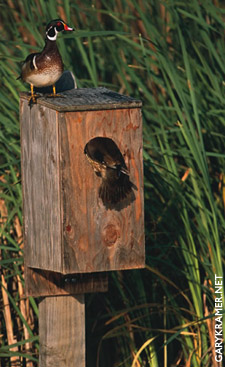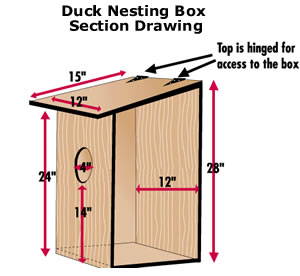Wood Duck Boxes
These wooden structures help boost local wood duck populations
These wooden structures help boost local wood duck populations
In precolonial times, the wood duck was likely the most abundant waterfowl species in eastern North America. Unfortunately, their distribution within densely settled regions made them readily accessible to market hunters throughout the year. Overharvesting, coupled with the destruction of bottomland habitats, drove these colorful birds to the brink of extinction by the early 20th century. The dramatic rebound of wood duck populations since that time can be largely attributed to protection provided by the Migratory Bird Treaty Act of 1918. However, the recovery of the wood duck was also assisted by the advent of artificial nesting structures, or wood duck boxes.
 |
|
Wood duck boxes provide an excellent opportunity for anyone to become involved in wildlife management. |
In 1937, the U.S. Biological Survey (now the U.S. Fish &Wildlife Service) erected 486 bark-covered slab wooden boxes, which are thought to have been designed by biologists Gil Gigstead and Milford Smith at Chautauqua National Wildlife Refuge in central Illinois. This represented the first recorded use of artificial nesting structures for wood ducks. Over the next two years, Arthur Hawkins and renowned wood duck expert Frank Bellrose erected 700 rough-cut cypress board boxes throughout Illinois. More than half were used by "woodies," revealing the great management potential of the boxes. Since these pioneering efforts, thousands of wood duck boxes have been built and erected by a diversity of people and groups, from wildlife agencies to conservation-minded private citizens.
Wood duck females typically build their nests in tree cavities near wetlands. When a prospective cavity is found, a hen wood duck will land in the tree and carefully inspect the site for a variety of characteristics, including size, shape and security from predators and the elements. In many areas, wood ducks have difficulty finding suitable natural nesting sites. Wood duck boxes provide a man-made alternative, where hens can nest in relative safety from predators. The deployment of large numbers of nesting boxes can be used to help increase local or regional populations of wood ducks in areas where natural cavities are limited.
Several important factors must be considered when selecting sites to place wood duck boxes. Suitable brood habitat must be available within a couple of hundred yards in order for ducklings to survive once they exit the box. In addition, shallow, fertile wetlands with thick cover and an abundance of invertebrates typically provide the best habitat for broods. Ideally, boxes should be erected on either wooden posts or metal conduits outfitted with predator guards.
While many types and styles of wood duck boxes have been produced from a variety of materials over the years, those made from rough-cut lumber, like the original prototypes built by Hawkins and Bellrose, seem to work best. Rough-cut, unfinished lumber is preferred because ducklings have no trouble climbing the inside of the box with their sharp claws to reach the exit hole. In plastic or metal structures, which have slick surfaces, hardware cloth ladders must be installed to provide ducklings with an escape route. Ideally, a four-inch layer of wood shavings should be added to each box for nesting material. The female will use this to cover the eggs during laying or when she takes feeding breaks during incubation. Boxes should be cleaned out and replenished with fresh nesting material every year in late winter, before hens initiate nesting in early spring.
 All nesting boxes should be secured to protect hens and their clutches from nest predators, especially raccoons and rat snakes. The most effective way to provide defense from these marauders is to install a predator guard on the pole supporting the box. Conical predator guards made of sheet metal are most effective. Care must be taken to ensure that the guard fits tightly against the post and that no overhanging tree limbs allow predators to bypass the predator shield.
All nesting boxes should be secured to protect hens and their clutches from nest predators, especially raccoons and rat snakes. The most effective way to provide defense from these marauders is to install a predator guard on the pole supporting the box. Conical predator guards made of sheet metal are most effective. Care must be taken to ensure that the guard fits tightly against the post and that no overhanging tree limbs allow predators to bypass the predator shield.
Although duckling production from nest boxes represents only a small percentage of that produced from natural cavities, wood duck boxes provide an excellent opportunity for anyone to become involved in wildlife management. By building, installing and maintaining nest boxes, individuals can gain insight into the interesting aspects of wood duck nesting and reproduction, while helping to boost local populations.
-Scott Stephens
Ducks Unlimited uses cookies to enhance your browsing experience, optimize site functionality, analyze traffic, and deliver personalized advertising through third parties. By continuing to use this site, you agree to our use of cookies. View Privacy Policy